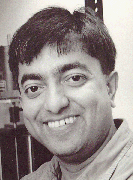

Professor Bhattacharjee, known by his friends as Sooby, earned a B.Tech. degree in Mechanical Engineering from Indian Institute of Technology, Kharagpur in 1983 and his Ph.D. from Washington State University, Pullman, USA in 1988. After two years of post-doctoral work on a NASA project, he joined San Diego State University in 1991 and currently holds Professorship in Mechanical Engineering Department and Adjunct Professorship in Computer Science Department.
Professor Bhattacharjee has been actively involved in research in radiation heat transfer, combustion, computational thermodynamics, and development of software for educational purposes. For his dissertation, he developed a modified two-flux method (Effective Angle Method) for calculating radiative source term and used this model to study two-way coupling between radiation and fluid dynamics in a laminar diffusion flame. Working on a project on jet flow in boundary layers, he came upon a new non-dimensional group that compares a known pressure drop with viscous forces. This number is being used in textbook and literature in connection with electronic cooling.
Throughout his research career, Dr. Bhattacharjee has been interested in uncovering the mechanism of flame spread over solid fuels, especially in a microgravity environment. His work helped establish the dominance of radiation heat transfer in near quiescent environment. He has been a PI and co-PI of several projects funded by NASA. Some of his contributions include: 1. Discovery of the phenomenon that flame over thick fuel bed in a quiescent microgravity environment self-extinguishes irrespective of the oxygen level; 2. Development of a formula for a critical thickness that renders a fuel thick in such an environment; 3. Development of two formulas for flame spread rate, one in the thin limit and one in the thick limit, which are the only flame spread formulas ever developed in the microgravity regime. Several of his experiments on flames over solids have been conducted aboard NASA's Space Shuttles, Sounding Rockets, and Russia's Mir Space Station. One of his recently proposed experiments is currently under design to be conducted in the International Space Station. Research results from his group can be accessed from http://flame.sdsu.edu.
With grants from NASA, Prof. Bhattacharjee and his team have been conducting fundamental experiments aboard the International Space Station to predict the behavior of flames in a gravity free environment of a spacecraft. In this work, researchers from Gifu and Toyohashi Universities, Japan, are collaborating with SDSU. One of the major objectives of this work is to predict at what rate flames spread over solid combustible surfaces in a gravity free enclosed environment. This work has implications to fire safety in the Space Station as well as future manned voyages.
Supported by NSF, Dr. Bhattacharjee has been developing a novel cyber infrastructure for multi-scale approach to thermodynamic data and chemical equilibrium services. Users can now plug in these services and "outsource" the data used in their thermofluids calculations. By simply altering key words such as NASA, NIST, or AB-INITIO, for example, they can change the source of data used in their research applications. Likewise, equilibrium calculations can be integrated into any CFD code written in FORTRAN, MATLAB, or any other language through a relatively new technology called web services. The chemical equilibrium program developed by Dr. Bhattacharjee's group is equally powerful as NASA's benchmark CEA and offers a built-in parallel architecture.
Prof. Bhattacharjee's passion for making thermodynamics easier to master led to the development of a webware (a web based software) called TEST, the Expert System for thermodynamics (www.thremofluids.net), regularly accessed by a huge number of students, professionals and educators from around the world. TEST has been translated to Spanish and Japanese and more than 150 educational institutions currently hold free academic site license to use TEST in their campuses. Several articles and one book have been written about the use of TEST in thermodynamic education. Unsolicited comments on how educators are finding this webware useful come almost every week from different corners of the world.

In Dec. 2014, Pearson has published a 700 page textbook, Thermodynamics: An Interactive Approach, that integrates TEST with traditional content, but breaks away from the traditional spiral approach to introduce content by adapting what he calls a layered approach where concepts such as entropy and exergy are introduced early and progressively refined in subsequent chapters. TEST is integrated so that students can switch between the textbook and TEST to watch animation, use the TESTcalcs as numerical laboratory, verify manual solutions, and pursue "what-if" scenarios.
Winner of Outstanding Faculty Award, Monty Award at SDSU, several Most Influential Faculty awards, Faculty Friend Award, Outstanding Engineering Educator award, Best Paper award, and ASME Fellow award, Professor Bhattacharjee can be contacted at prof.bhattacharjee@gmail.com.